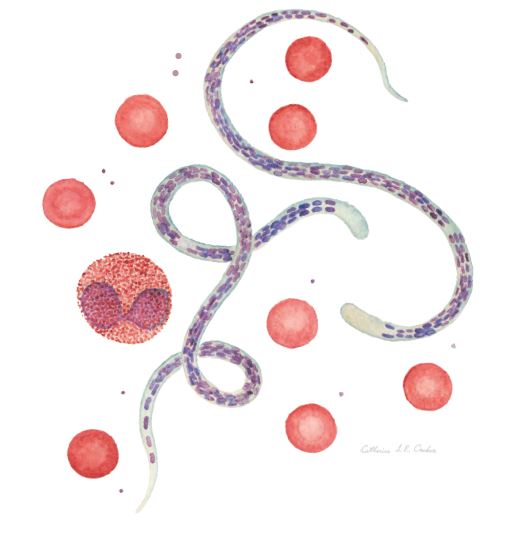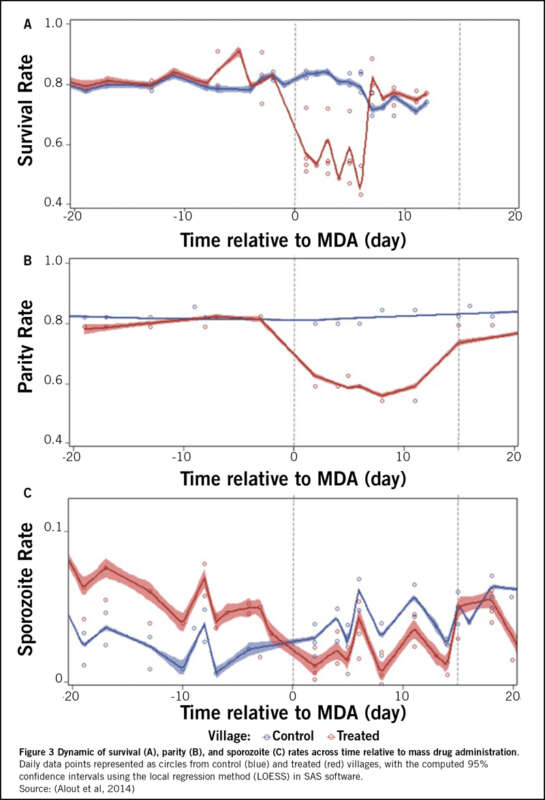
Impact of ivermectin in onchocerciasis control could be just the beginning
The iconic story behind onchocerciasis elimination efforts offers lessons that extend well into the present day and beyond. Not only did the Onchocerciasis Control Program (OCP) and Mectizan Donation Program (MDP) provide evidence as to the power and potential for large-scale public and private partnerships and community-directed treatment, they gave rise to further studies suggesting these programs will continue to bear fruit far into the future.
In addition to successes attributable to unprecedented collaboration between global and regional entities, a more direct and far-reaching benefit has since begun to emerge: use of ivermectin and other avermectins beyond helminthic infection.
Partners in Progress Series:
As the impact of OCP and MDP were becoming apparent in the 1990s, researchers were already beginning to investigate potential new uses for ivermectin for a wider range of vector-borne diseases. Multiple studies surrounding the effects of ivermectin on mosquito species and in the veterinary realm were published soon after these programs were put in place. Although initial research was focused on expanding ivermectin use in animal health, the first journal article referencing use of ivermectin for human volunteers was published at the turn of the century (Foley, 2000).
Malaria Drove Research
Malaria control was the logical object of these studies and a natural extension of ivermectin research. The powerful Streptomyces avermitilis derivative had already demonstrated strong efficacy against arthropods including mosquitoes, and boasted an excellent safety profile. More than two billion doses of ivermectin would have been administered for onchocerciasis and lymphatic filariasis control in the 25 years following ivermectin introduction.

Moreover, ivermectin had attributes with the potential to solve fundamental hurdles that were beginning to emerge in the malaria control sector. While significant gains in the fight against malaria had been achieved by the year 2010, the Malaria Eradication (malERA) Consultative Group outlined several challenges to continued progress in 2011. Central to those findings was the need for new interventions to complement existing, but increasingly at-risk, vector control efforts.
Much of the progress in malaria efforts to that point were attributable to use of chemical-based adulticides against Anopheles spp. via indoor residual sprays (IRS) and distribution of insecticide-treated bed nets (ITN). While these interventions proved effective against endophilic mosquito species, they were of little use against exophilic mosquitoes, feeding out-of-doors. A second major threat cited by malERA was that vector control efforts were beginning to suffer the onset of insecticide resistance among both endophilic and exophilic targets, a challenge that has continued growing more problematic through the present day.
Ten years after Foley, a landmark study “Effect of Ivermectin on Anopheles gambiae Mosquitoes Fed on Humans: The Potential of Oral Insecticides in Malaria Control” (Chaccour, 2010) took the idea of using ivermectin for malaria control one step further. The team from the London School of Hygiene and Tropical Medicine (LSHTM) conducted a randomized laboratory study to examine the survival rate of A. gambiae mosquitos who fed on humans dosed with ivermectin, versus a control.
Results from the study were eye-opening and confirmed what data from pre-existing animal health studies suggested: the mortality rate of mosquitoes feeding on volunteers given ivermectin accelerated dramatically versus mortality from the control group. Mean survival for mosquitoes feeding from ivermectin-treated volunteers was only 2.38 days, compared to a mean survival of 5.52 days in the control group. Mosquito mortality recorded on days 2-4 in the ivermectin group was 73 percent, 84 percent, and 89 percent, respectively, while mortality in the control group was logged at 32 percent, 38 percent, and 4 percent over the same period.
The implications of the study were profound. Not only did it reinforce the notion that ivermectin could be a complimentary means to combating malaria, the findings suggested that such an intervention could directly address the challenges being spelled out by malERA. A novel intervention delivered directly into the human bloodstream could potentially help reduce the longevity of both endophilic and exophilic malaria vector populations while at the same time adding a different mode of action and application to the limited toolbox of malaria vector interventions.
Questions remained, nonetheless, as the study also revealed that direct effects of ivermectin were relatively short-lived. At 14 days after the ivermectin treatment, no difference in mortality was observed between groups. And since the need for a second dose of ivermectin (behavior modification) had plagued OCP efforts in many onchocerciasis-endemic areas, the feasibility of administering ivermectin therapy at a much higher frequency for malaria control remained unclear.
However, despite demonstrating limited persistence and effects on mosquito mortality, the LSHTM study suggested that mosquitoes in the ivermectin group demonstrated the same lack of movement coordination observed in affected parasitic nematodes. This meant that paralysis, and the inability to fly, was observed in ivermectin-affected mosquitos. These effects suggested potentially wider impacts from ivermectin on mosquito ecology and population dynamics.
Gaining Momentum
Over the course of the next two years, seven additional studies would be published surrounding various aspects of ivermectin impact on mosquito ecology, traits, and behavior. Investigations included impacts on mosquito survival, population structure, immigration, inoculation rate, and vectorial capacity.
Global malaria eradication will require new tools and the implementation of an integrated approach targeting the vector and parasite in the ever changing human reservoir. The (malERA) has identified three main challenges to developing vector targeted interventions that support elimination and eradication goals. The first challenge is developing a broader range of insecticides with novel modes of action to counter current insecticide resistance among Anopheles species. Secondly, to develop control methods that affect outdoor feeding and resting vectors; the third is that new interventions are needed to reduce the extremely high vectorial capacities of malaria vectors.
Ivermectin to reduce malaria transmission a research agenda
for a promising new tool for elimination” (Chaccour, 2013)
Perhaps the most impactful study that built on the body of research to date was published by Alout et al. in late 2014. “Evaluation of ivermectin mass drug administration for malaria transmission control across different West African environments” extended the examination of ivermectin administration to exogenic mosquitos in wild, as well as those captured indoors. As well as measuring mosquito survival rate, the study also made the important connections that examined the effects of ivermectin on sporozoite rate (proportion of infective mosquitoes in a vector population) and parity rate (the female’s ability to produce offspring) among affected populations.
In the Alout study, blood-fed Anopheles mosquitoes harboring indoors were captured along with outdoor-resting Anopheles on days immediately following Mass Drug Administration (MDA) of ivermectin at multiple village sites over a period from 2008 through 2013.
Similar to the results obtained in earlier studies, mosquito survival rates were dramatically affected by MDA treatments. The day-three survival rate of mosquitoes from untreated villages was 82.3 percent (± 2 percent) compared to just 54.4 percent (± 3.2 percent) in treated villages, a reduction of about 34%.

While sporozoite rates in control villages did not change significantly over time, rates in treated villages declined by more than 400%, from 5.31 percent (± 1.2 percent) before ivermectin treatments to 1.19 percent (± 0.7 percent) in week 2 following the MDA. This dramatic decline in Plasmodium falciparum infection among mosquitoes in treated villages – well beyond the shorter-term, direct impact on mosquito mortality – suggested a direct correlation to parity and population dynamics.
Indeed, dissection of a random batch of ≈ 20 females from mosquito populations in treated villages bore the data out. By observing the presence of coiled or uncoiled ovarian tracheoles, researchers found that parity rate among females in treated villages declined from 80.7 percent (± 3.6 percent) before MDA treatments to 58 percent (±7 percent) in the second week following treatment. Researchers interpreted these results as a 78 percent reduction in vectorial capacity for mosquito populations in treated areas over the two-week period.
Summary and Future Implications
To quickly recap the collective results of these studies, several conclusions can be drawn:
- Ivermectin has a powerful effect on Anopheles mosquito mortality. In the days following MDA, the presence of ivermectin in the blood host has a conspicuous effect on the survival rate of actively feeding mosquitoes
- While this direct effect is relatively short, resulting effects on parity and sporozoite rates combine to limit vectorial capacity for a longer period of time
- These factors have tremendous potential to address growing concerns of insecticide resistance that limit the effectiveness of existing mosquito control tools
While each of the studies examined were limited to Anopheles species in the context of malaria control efforts, even broader possibilities might be implied by these results.
For one, it seems reasonable that the effects of ivermectin could potentially extend beyond the referenced species to include other important mosquito vectors such as Aedes aegypti, Aedes albopictus and various Culex spp. If that is true, it follows that ivermectin could be an important intervention for a variety of mosquito-borne diseases beyond malaria, diseases such as Dengue, West Nile Virus, Eastern Equine Encephalitis, Zika, and others.
Finally, the demonstrated effectiveness of avermectins and ivermectin technology seems poised to spawn research into other Streptomyces avermitilis derivatives as well as new innovations in the systems used to deliver future interventions.
Who knows what the future will hold?
Chaccour et al.: Effect of Ivermectin on Anopheles gambiae Mosquitoes Fed on Humans: The Potential of Oral Insecticides in Malaria Control. The Journal of Infectious Diseases 2010; 202(1):113-116.
Chaccour et al.: Ivermectin to reduce malaria transmission: a research agenda for a promising new tool for elimination. Malaria Journal 2013 12:153.
Alout et al.: Evaluation of ivermectin mass drug administration for malaria transmission control across different West African environments. Malaria Journal 2014 13:417.